 Well I bought my first Inspiration in 2001. It was what is now termed a Classic
but, let's admit it, it was the MkII Classic, check the case clips, as APD had
released their first version in 1997 and were already improving things. Writing
it up then was fun as rebreather diving was a black art and a lot of people
thought it was only a matter of time before we all died, "Should be sold with a
shovel" was the call. Well I'm sorry to say that I, and many others, have
disappointed the prophets of doom. I updated my Classic with the Vision parts
when they launched the improved version of the electronics (2006) and I was
pleased with it. We did a lot of happy diving together and had a lot of fun.
Frankly, most of my fond diving memories have the old yellow box at my back.
Writing up my new toy today seems rather dull as Rebreathers are now pretty
much main stream diving and I'm not planning doing much special to it. However
I've got to do it because otherwise this website will be just wrong.
Well I bought my first Inspiration in 2001. It was what is now termed a Classic
but, let's admit it, it was the MkII Classic, check the case clips, as APD had
released their first version in 1997 and were already improving things. Writing
it up then was fun as rebreather diving was a black art and a lot of people
thought it was only a matter of time before we all died, "Should be sold with a
shovel" was the call. Well I'm sorry to say that I, and many others, have
disappointed the prophets of doom. I updated my Classic with the Vision parts
when they launched the improved version of the electronics (2006) and I was
pleased with it. We did a lot of happy diving together and had a lot of fun.
Frankly, most of my fond diving memories have the old yellow box at my back.
Writing up my new toy today seems rather dull as Rebreathers are now pretty
much main stream diving and I'm not planning doing much special to it. However
I've got to do it because otherwise this website will be just wrong.
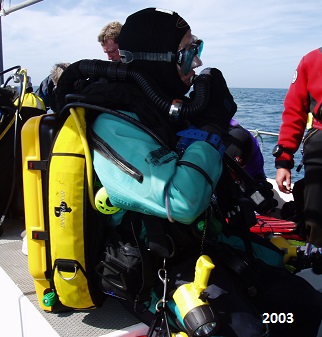 In about 2008 I was having problems doing the Mod 3 (hypoxic trimix) course on
the Inspiration. A previous hobby has left my shoulders damaged and, with the
added constraints of a dry suit, I just didn't have the reach that many other
people do and I could not do all the required stage handling with the front
counter lungs and floppy D-rings without a lot of complications.
In about 2008 I was having problems doing the Mod 3 (hypoxic trimix) course on
the Inspiration. A previous hobby has left my shoulders damaged and, with the
added constraints of a dry suit, I just didn't have the reach that many other
people do and I could not do all the required stage handling with the front
counter lungs and floppy D-rings without a lot of complications.
|
|
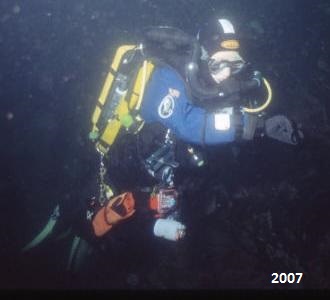 I'm not going to describe in detail what I have as you can see it on APD's
website, provided you allow for the fact that the model is now rebranded as the
Inspiration xpd. I have deliberately gone for a very conservative system
with no complicated case and harness redesigns. Notice that I have stuck with
the Inspiration xpd not the smaller evp/evo simply because I like the way it
sits down with me. Look at the old 2003 picture. I am sitting on a bench with
no weight on my back and I just sat down into the rebreather and did up the
harness.
I'm not going to describe in detail what I have as you can see it on APD's
website, provided you allow for the fact that the model is now rebranded as the
Inspiration xpd. I have deliberately gone for a very conservative system
with no complicated case and harness redesigns. Notice that I have stuck with
the Inspiration xpd not the smaller evp/evo simply because I like the way it
sits down with me. Look at the old 2003 picture. I am sitting on a bench with
no weight on my back and I just sat down into the rebreather and did up the
harness.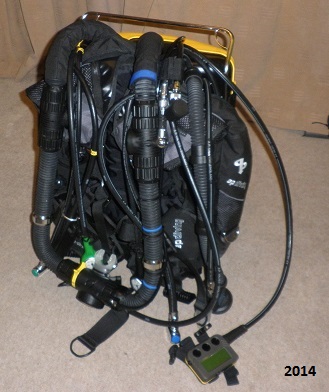 Well, I sent off the money in mid December so I knew I wasn't actually going to
get it for Christmas but was unfortunate enough to hit APD's big rebranding
exercise at the beginning of 2014. Well perhaps that was why it took well over
two months before they had all the bits together to assemble mine and ship it
out. This meant that at the beginning of March, after it had been mistakenly
sent to the dealer, picked up from there and resent to me at my home address
not the office as requested, but where, thankfully, it was taken in by a
neighbour that it finally arrived.
Well, I sent off the money in mid December so I knew I wasn't actually going to
get it for Christmas but was unfortunate enough to hit APD's big rebranding
exercise at the beginning of 2014. Well perhaps that was why it took well over
two months before they had all the bits together to assemble mine and ship it
out. This meant that at the beginning of March, after it had been mistakenly
sent to the dealer, picked up from there and resent to me at my home address
not the office as requested, but where, thankfully, it was taken in by a
neighbour that it finally arrived.
 I find the Vision handset reasonably intuitive. OK, you still need to remember
the magic key presses to get into the right menu modes but they are not complex
and you then step through the options. I have strong views on dive computer and
rebreather interfaces and this is one of the better ones. Also it takes orders
and, unless it has totally lost the plot, does not give them. I rather feel it
wants to be part of the solution not part of the problem.
I find the Vision handset reasonably intuitive. OK, you still need to remember
the magic key presses to get into the right menu modes but they are not complex
and you then step through the options. I have strong views on dive computer and
rebreather interfaces and this is one of the better ones. Also it takes orders
and, unless it has totally lost the plot, does not give them. I rather feel it
wants to be part of the solution not part of the problem.
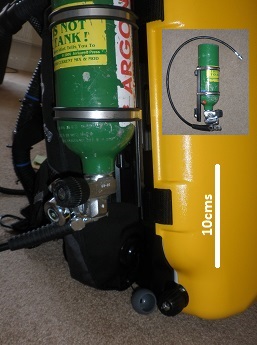 A lesser problem was that the OCB itself was, as delivered, very stiff. It made
things like a negative check relatively hard and it was not such as simple job
to close off the loop as it ought to be. However it only took me a couple of
days to get over the 'new' syndrome and then it came apart for a re-lube. I was
very careful to remove all the original grease and clean all the parts very
thoroughly and then redo it with new grease applied to get a 'shine not a
smear' and it is now vastly better: more like the old Classic. It is a one
handed - well one hand and a mouth - operation now much as I felt it ought to
be.
A lesser problem was that the OCB itself was, as delivered, very stiff. It made
things like a negative check relatively hard and it was not such as simple job
to close off the loop as it ought to be. However it only took me a couple of
days to get over the 'new' syndrome and then it came apart for a re-lube. I was
very careful to remove all the original grease and clean all the parts very
thoroughly and then redo it with new grease applied to get a 'shine not a
smear' and it is now vastly better: more like the old Classic. It is a one
handed - well one hand and a mouth - operation now much as I felt it ought to
be.
 When you're putting it on there is an awful lot of things coming over the
shoulders in the same place, all trying to snag up on one another. Putting on
any complex dive rig is always a bit of a trial but I'm sure something can be
done about this. It might just be something simple like some Velcro tape to
hold things together rather than letting them just slop about. In the water
it's not too bad although the AutoAir does tend to wander off and hide but,
thankfully, it is negative so the old 'arm sweep' we teach novices to use to
find a regulator gets it back. Interestingly after a couple of pool sessions
using it 'underarm' began to feel quite good. Naturally you then have to use
the 'pull to dump' feature as holding it up isn't going to happen.
When you're putting it on there is an awful lot of things coming over the
shoulders in the same place, all trying to snag up on one another. Putting on
any complex dive rig is always a bit of a trial but I'm sure something can be
done about this. It might just be something simple like some Velcro tape to
hold things together rather than letting them just slop about. In the water
it's not too bad although the AutoAir does tend to wander off and hide but,
thankfully, it is negative so the old 'arm sweep' we teach novices to use to
find a regulator gets it back. Interestingly after a couple of pool sessions
using it 'underarm' began to feel quite good. Naturally you then have to use
the 'pull to dump' feature as holding it up isn't going to happen.
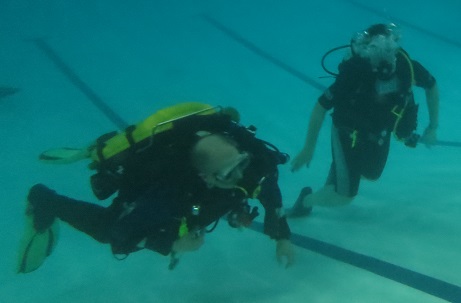 Obviously both these cylinders are mounted valve down for ease of access. I am
not a contortionist. Dive prepped but never been in the water yet I weighed
this system as 45Kgs dry weight with no lead. That, obviously, wasn't exactly
good news.
Obviously both these cylinders are mounted valve down for ease of access. I am
not a contortionist. Dive prepped but never been in the water yet I weighed
this system as 45Kgs dry weight with no lead. That, obviously, wasn't exactly
good news.
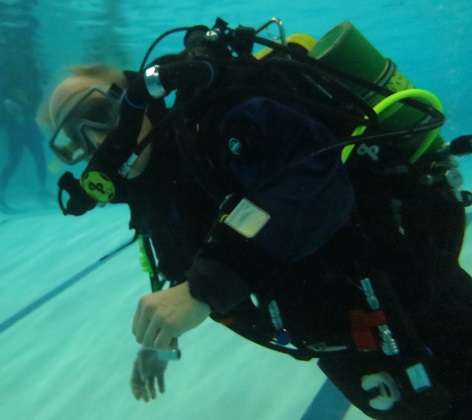 I had also ordered a pile of spares, mostly O-rings, service kits and an oxygen
cell because it seemed prudent to have them in the dive box, then a pile of
batteries and three tools from the Kent Tooling web-site (yes you do need both
sizes of spanner) to help with looking after it. Along the way I made the happy
discovery that my current Metalsub clip on cylinder mounts, that I bought for
my first Inspiration and had moved to the Sentinel, are an exact fit with the
APD parts. I knew they were the same maker but I was happy to discover they
were the same size.
I had also ordered a pile of spares, mostly O-rings, service kits and an oxygen
cell because it seemed prudent to have them in the dive box, then a pile of
batteries and three tools from the Kent Tooling web-site (yes you do need both
sizes of spanner) to help with looking after it. Along the way I made the happy
discovery that my current Metalsub clip on cylinder mounts, that I bought for
my first Inspiration and had moved to the Sentinel, are an exact fit with the
APD parts. I knew they were the same maker but I was happy to discover they
were the same size.
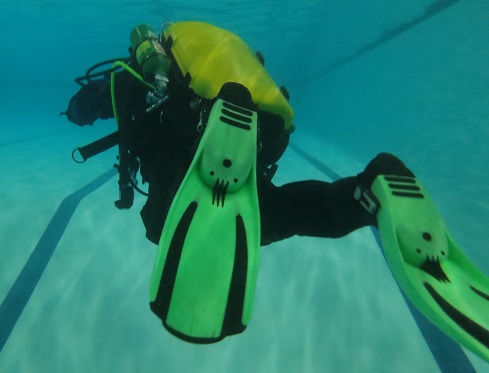 Other snags? Nothing much. The flow-stop on the ADV defeated me. I managed it a
couple of times but the nest of hoses made it difficult to identify things. The
buzzer sits right in the wrong place. This will need some attention before I
want to touch that in gloves. Also I must memorise pull (forwards) to shut off
and learn to distinguish the sliding part from the rest by feel.
Other snags? Nothing much. The flow-stop on the ADV defeated me. I managed it a
couple of times but the nest of hoses made it difficult to identify things. The
buzzer sits right in the wrong place. This will need some attention before I
want to touch that in gloves. Also I must memorise pull (forwards) to shut off
and learn to distinguish the sliding part from the rest by feel.
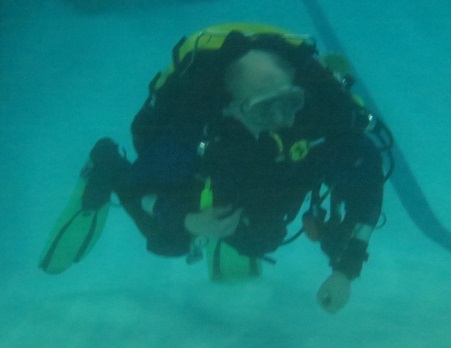 Well it spent a week sitting on the workbench at home being messed with trying
to improve things. Most of the big gains were little changes like slightly
rerouting hoses and then restraining them so they were in the right place to
put it on and stayed in the right place once it was on. That might sound
trivial but it makes a lot of difference when you don't bend very well. Then I
swapped the 36" drysuit hose I originally had for the 31" version so it routed
in a bit more snugly. I might do the same to the OCB hose but I'm not quite
sure yet where 'neater' ends and 'restrictive if I turn my head' begins yet but
I've ordered one that's a bit shorted (in blue) to try. I also swapped up a
size on the HUD holder and moved it to the other side so it didn't mess up my
head-cam sighting grid.
Well it spent a week sitting on the workbench at home being messed with trying
to improve things. Most of the big gains were little changes like slightly
rerouting hoses and then restraining them so they were in the right place to
put it on and stayed in the right place once it was on. That might sound
trivial but it makes a lot of difference when you don't bend very well. Then I
swapped the 36" drysuit hose I originally had for the 31" version so it routed
in a bit more snugly. I might do the same to the OCB hose but I'm not quite
sure yet where 'neater' ends and 'restrictive if I turn my head' begins yet but
I've ordered one that's a bit shorted (in blue) to try. I also swapped up a
size on the HUD holder and moved it to the other side so it didn't mess up my
head-cam sighting grid.
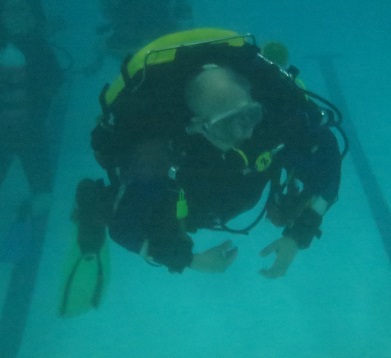 The third night in the pool
The third night in the pool
 And proper dives
And proper dives
 After about six months I was in the Farnes and I had some cell trouble which I
had never had before. Since Telidyne had quit the rebreather cell market
because, I believe, they were tired of being cited as a co-defendant in
liability trials that APD then won, but only after lots of legal fees had
already been run up. Poor old APD then went through several cell manufacturers
to get something that worked as consistently as the old cells. I won't bore you
with my version of the AP12/14/16 saga but I found I needed a cable to connect
to the SMB connector on a cell to read off the voltages because it's a bit
small and I'm too clumsy to just do it with the usual voltmeter probes.
After about six months I was in the Farnes and I had some cell trouble which I
had never had before. Since Telidyne had quit the rebreather cell market
because, I believe, they were tired of being cited as a co-defendant in
liability trials that APD then won, but only after lots of legal fees had
already been run up. Poor old APD then went through several cell manufacturers
to get something that worked as consistently as the old cells. I won't bore you
with my version of the AP12/14/16 saga but I found I needed a cable to connect
to the SMB connector on a cell to read off the voltages because it's a bit
small and I'm too clumsy to just do it with the usual voltmeter probes. OCB
OCB
| 3/300 steel pony tank | 5.95Kg | 1.91Kg | |
| 2/300 carbon pony tank | 2.44Kg | -0.64Kg | that means buoyant when empty |
| 2/200 suit tank | 4.21Kg | 1.28Kg | including reg and hose |
| Fami 75W torch | 2.48Kg | 1.19Kg | |
| set of regs for the pony tanks | 1.43Kg | 0.83Kg | |
| Apollo scooter | 18Kg | 1.9Kg | |
| a block of lead | 1.00Kg | 0.91Kg | no kidding |
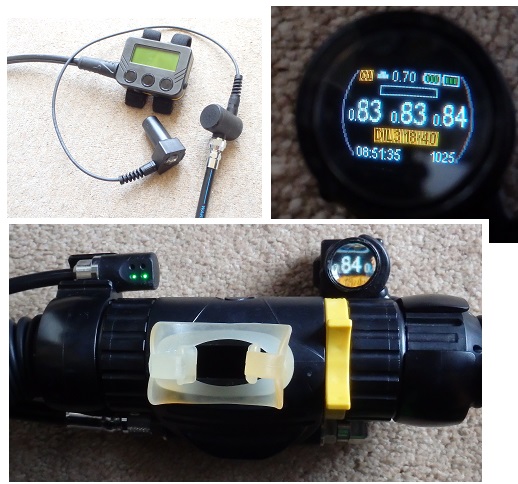 OK, I'm a sucker for shiny new gadgets and so when APD offered a head up
display (HUS) and rechargeable batteries I was all over the promo web pages.
Now I'll be the first to admit that I don't need either of these, I get nervous
diving OC because there isn't something on my wrist reassuring me that what I'm
breathing is what I want but it's OLEDs and OLED displays make me go all
fangirl SQUEEEE!...
OK, I'm a sucker for shiny new gadgets and so when APD offered a head up
display (HUS) and rechargeable batteries I was all over the promo web pages.
Now I'll be the first to admit that I don't need either of these, I get nervous
diving OC because there isn't something on my wrist reassuring me that what I'm
breathing is what I want but it's OLEDs and OLED displays make me go all
fangirl SQUEEEE!... I was a bit perplexed by the kit of bits that arrived. The system comes with
comprehensive operating notes but you are rather left to yourself on how to fit
it. It obviously goes on the right hand side of the mouthpiece and they
recommend wrapping the cable round the hose so I used the two Velcro ended tabs
they supplied to lash the buzzer to the other side to normal and that seemed to
do it. Admittedly I used to have the disco lights on that side so I swapped
them back to the left and dug out the shorter clip to hold them.
I was a bit perplexed by the kit of bits that arrived. The system comes with
comprehensive operating notes but you are rather left to yourself on how to fit
it. It obviously goes on the right hand side of the mouthpiece and they
recommend wrapping the cable round the hose so I used the two Velcro ended tabs
they supplied to lash the buzzer to the other side to normal and that seemed to
do it. Admittedly I used to have the disco lights on that side so I swapped
them back to the left and dug out the shorter clip to hold them.
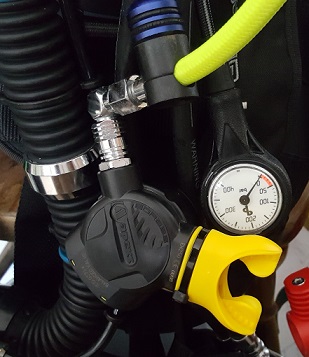 Overall I would say that the changes that they have rolled out since I got this
new unit have been solid improvements. I confess I don't dive as much as I used
to now but having the 'best mix for the dive' that a rebreather gives me is
probably even more important as I grow older. Maybe I wish it didn't weigh
quite so much but much of that is lead to deal with the unavoidable airspaces
that a rebreather must have to give it a free-flowing loop. I'm pretty sure
I've got a good few years diving left in me but I suspect I won't ever fill the
3000 hours of log space I have now.
Overall I would say that the changes that they have rolled out since I got this
new unit have been solid improvements. I confess I don't dive as much as I used
to now but having the 'best mix for the dive' that a rebreather gives me is
probably even more important as I grow older. Maybe I wish it didn't weigh
quite so much but much of that is lead to deal with the unavoidable airspaces
that a rebreather must have to give it a free-flowing loop. I'm pretty sure
I've got a good few years diving left in me but I suspect I won't ever fill the
3000 hours of log space I have now.